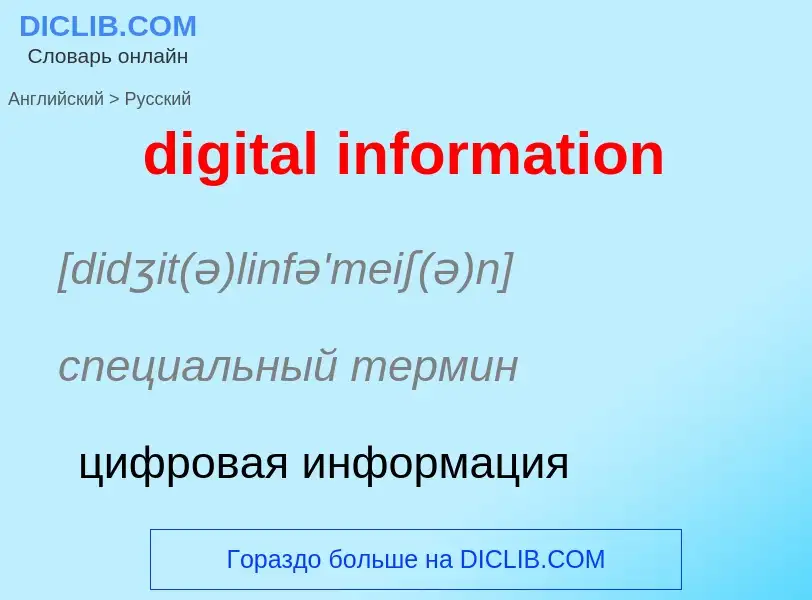Перевод и анализ слов искусственным интеллектом ChatGPT
На этой странице Вы можете получить подробный анализ слова или словосочетания, произведенный с помощью лучшей на сегодняшний день технологии искусственного интеллекта:
- как употребляется слово
- частота употребления
- используется оно чаще в устной или письменной речи
- варианты перевода слова
- примеры употребления (несколько фраз с переводом)
- этимология
digital information - перевод на русский
[didʒit(ə)linfə'meiʃ(ə)n]
специальный термин
цифровая информация
нефтегазовая промышленность
цифровая трасса
[infə'meiʃ(ə)n'saiəns]
синоним
общая лексика
DTV
цифровое телевидение
стандарт цифрового телевизионного вещания, принятый в США в декабре 1996 г. Коммерческие телестанции должны начать вещание в цифровом режиме к 1 мая 2002 г
общая лексика
цифровое неравенство
неравенство между различными слоями населения, возникающее из-за невозможности малообеспеченным гражданам пользоваться преимуществами информационных технологий, Интернетом, дистанционным обучением, дистанционным рекрутингом и т.д. Подобное неравенство возникает и между населением стран с разным уровнем развития
Википедия

Digital data, in information theory and information systems, is information represented as a string of discrete symbols, each of which can take on one of only a finite number of values from some alphabet, such as letters or digits. An example is a text document, which consists of a string of alphanumeric characters. The most common form of digital data in modern information systems is binary data, which is represented by a string of binary digits (bits) each of which can have one of two values, either 0 or 1.
Digital data can be contrasted with analog data, which is represented by a value from a continuous range of real numbers. Analog data is transmitted by an analog signal, which not only takes on continuous values but can vary continuously with time, a continuous real-valued function of time. An example is the air pressure variation in a sound wave.
The word digital comes from the same source as the words digit and digitus (the Latin word for finger), as fingers are often used for counting. Mathematician George Stibitz of Bell Telephone Laboratories used the word digital in reference to the fast electric pulses emitted by a device designed to aim and fire anti-aircraft guns in 1942. The term is most commonly used in computing and electronics, especially where real-world information is converted to binary numeric form as in digital audio and digital photography.



![[[Gottfried Wilhelm Leibniz]], a German [[polymath]] who wrote primarily in Latin and French. His fields of study were [[Metaphysics]], [[Mathematics]], [[Theodicy]]. [[Gottfried Wilhelm Leibniz]], a German [[polymath]] who wrote primarily in Latin and French. His fields of study were [[Metaphysics]], [[Mathematics]], [[Theodicy]].](https://commons.wikimedia.org/wiki/Special:FilePath/Gottfried Wilhelm Leibniz, Bernhard Christoph Francke.jpg?width=200)
![[[Joseph Marie Jacquard]] [[Joseph Marie Jacquard]]](https://commons.wikimedia.org/wiki/Special:FilePath/Joseph Marie Jacquard.jpg?width=200)
![[[Vannevar Bush]], a famous information scientist, ca. 1940–1944 [[Vannevar Bush]], a famous information scientist, ca. 1940–1944](https://commons.wikimedia.org/wiki/Special:FilePath/Vannevar Bush portrait.jpg?width=200)
![A picture showing scratches on the readable surface of a CD-R. Music and data CDs are coded using error correcting codes and thus can still be read even if they have minor scratches using [[error detection and correction]]. A picture showing scratches on the readable surface of a CD-R. Music and data CDs are coded using error correcting codes and thus can still be read even if they have minor scratches using [[error detection and correction]].](https://commons.wikimedia.org/wiki/Special:FilePath/CDSCRATCHES.jpg?width=200)
![Comparison of image quality between [[ISDB-T]] (1080i broadcast, top) and [[NTSC]] (480i transmission, bottom) Comparison of image quality between [[ISDB-T]] (1080i broadcast, top) and [[NTSC]] (480i transmission, bottom)](https://commons.wikimedia.org/wiki/Special:FilePath/Digital & Analog TV screen quality comparison-1.jpg?width=200)

![A laptop lending kiosk at [[Texas A&M University–Commerce]]'s Gee Library A laptop lending kiosk at [[Texas A&M University–Commerce]]'s Gee Library](https://commons.wikimedia.org/wiki/Special:FilePath/13394-Laptops Anytime Launch-6629 (10844113484).jpg?width=200)


